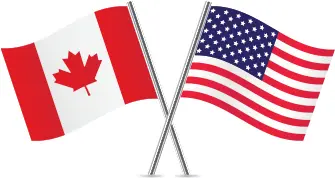The Canadian Food Inspection Agency (CFIA) passed amendments to overhaul many aspects of its current labeling requirements back in 2016. This shift will take Canadian labels from among the most opaque to possibly the most transparent in the world.
These changes will have a direct impact on Canadian food manufacturers and importers into Canada. The major amendments include a revised nutrition label, list of ingredients, serving size, sugars, and food color requirements.

Although some of the required updates are simple formatting changes, others are more specific. For example, by 2021, brands must call out all sugar-based ingredients in brackets after the listing of ‘sugar’. Additionally, the CFIA is requiring food manufacturers to be more transparent about colors. The upcoming amendments will also require food companies to list colors by their specific names.
Ingredients: flour, fancy molasses, vegetable oil shortening, brown sugar, liquid whole egg, sugar, salt, sodium bicarbonate, spices, color
Contains: wheat, egg
Ingredients: Sugars (fancy molasses, brown sugar, sugar) · Flour · Vegetable oil shortening · Liquid whole egg · Salt · Sodium bicarbonate · Spices Allura red · Tartrazine
Contains: Wheat · Egg
Historically, from a color standpoint, products manufactured in or exported to Canada were advised to declare the use of food coloring in an ingredient statement simply as “color”. The CFIA’s new guidelines state where ‘color’ was previously accepted, food companies must now declare all used colors by their common names. For example, “Allura Red” must be declared on the label if using the popular synthetic colorant.
Specifically, the CFIA states the following about the 2021 labeling changes for food colors:
Canada will also allow for the use of the U.S. common name in conjunction with the common name; e.g., “Allura Red (Red 40)”.

The US FDA is known to have extremely strict restrictions for food colors. So how do Health Canada’s new guidelines compare?
In the US, ingredients intended to impart color must be approved individually. Under Canada’s new guidelines, common names may be used when juices are used for color.
Certain colors may be approved in either the US or Canada but not the other. Until 2016, Spirulina was one such color.
In the United States, with the notable exception of carmine or cochineal extract, color additives exempt from certification (often casually referred to as “natural colors”) can be listed collectively as “artificial colors”, “artificial color added”, “color added”, or equally informative terms, without naming each one. These labels are not approved under the new Health Canada guidelines.
This is a common question my team gets: Can products made in or imported to Canada have labeling that reads “fruit juice” or “vegetable juice” for color? The short answer is no. This was not permitted before the labeling changes, and it is most certainly not permitted under the new regulations. However, juice from an approved source can be used to color and can be labeled using its common name. Check out these examples for black carrot, also known as purple carrot:

Never Permitted

No Longer Permitted

No Longer Permitted

No Longer Permitted

Always Permitted

Always Permitted

Always Permitted
A color preparation (often known alternatively as a “color system” in the United States) is a blend of ingredients designed to impart color. This doesn’t mean that a label can read “fruit juice blend”. Powdered colors all have carriers, such as maltodextrin, that perform critical functions and need to be labeled as incidental ingredients. These can be treated either as an approved color preparation, labeled as a single item (such as “Beta Carotene Powder”), or as a blend of multiple components labeled individually with their common names (such as “Beta Carotene, Maltodextrin”).
As the food industry and governing regulatory bodies strive to create greater transparency for the information hungry consumers of today, Sensient’s dedicated global regulatory team is here to assist with any guidance regarding the upcoming labeling changes in Canada.
In our years of experience, labeling changes have often spurred great innovation in the industry.
Sensient Colors can help food manufacturers navigate the regulatory landscape and meet consumer demand for transparency. Our team is happy to answer any questions about compliance with the CFIA’s 2021 guidelines. Please feel free to start a conversation about natural colors or food color regulation by requesting a consult below.